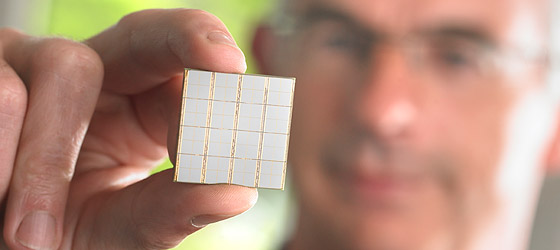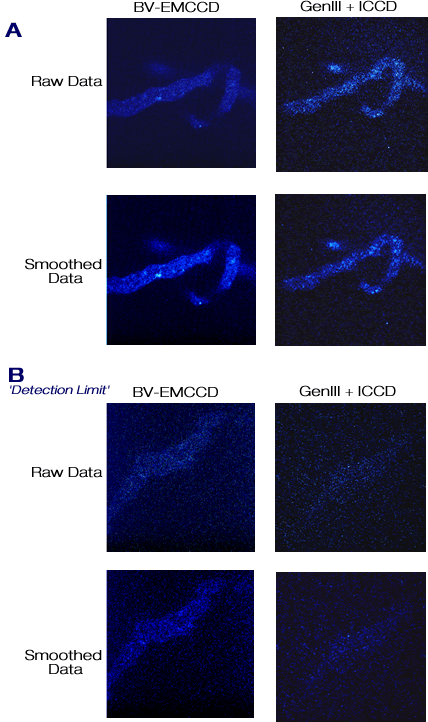Cameras for ultra low light levels
Many image sensors are built backwards, just like the retina. The actual photon detectors are buried behind a mesh of circuitry. Back-illuminated sensors, where the detectors are put in front, were a big step forward for light-limited applications. Now they’re so common, even the iPhone 4 has a back-illuminated CMOS camera. A couple of other big steps forward were intensified CCDs and electron multiplying CCDs.
In electron multiplying CCDs (EMCCDs) (some nice tutorials) the signal is amplified on chip, just prior to reading. So read noise is vastly improved. Of course, the dark noise is also amplified, but in practice this hasn’t been a large limitation. At low light levels, their main competitor is intensified CCDs (ICCDs). When imaging fast, and with around 10 photons/pixel, it’s a hard call whether to go with an ICCD or an EMCCD. The EMCCD needs aggressive cooling and does better with slower frame rates, but the ICCD has only a 50% QE compared to the >90% QE of EMCCDs. There are some analyses of the signal-to-noise ratio under different circumstances in ICCDs and EMCCDs (e.g., this, this, and this pdf), but it’s a thorny issue. I recommend you demo both. Also keep in mind that EMCCDs age in response to usage of the high gain modes (pdf).
These products aren’t to market yet, but they’re something to keep an eye on: micro single photon detectors. Philips has an 8×8 array of avalanche photodiodes, which has on-chip amplifiers and photon counting. Hamamatsu has a MEMS PMT. Among other things, this technology raises the possibility of an image sensor with 120 dB of dynamic range.




What about the sensitivity of the new scientific CMOS (sCMOS) cameras ? I’m not talking about photon counting here, but how does it compare to EMCCDs for regular live cell imaging ?
Hi Christophe,
sCMOS is a great example of how how CMOS technology can deliver high performance image detectors. What’s special about them is that they excel in several specifications, including resolution, pixel size, speed, noise, dynamic range. They are a “no compromises” imaging solution. Of course, this jack-of-all-trades is a master of none, but honestly, it’s really really close to a master in several of them. So for overall flexibility, and bang-for-your-buck, sCMOS is a great option.
For very low light levels, EMCCDs still have an advantage over sCMOS:
http://www.scmos.com/files/high/scmos%20figure%2013.tif
For higher light levels, the best option may be a nice slow-scan CCD.
For overall flexibility, both high and low light level applications, I suggest you test several cameras, including an sCMOS-based camera. None of these things are cheap, and vendors should be happy to demo them for you.
[…] the last post, commenter Christophe asked about sCMOS cameras. He was interested in higher light level […]
[…] choices. If you are operating in a light-limited regime (e.g., flavoprotein fluorescence imaging), EMCCDs are the way to […]
Yes, looking at the specs of the GenIIsCMOS cameras (Hamamatsu has a nice layout with interesting spec comparisons with their Flash 4.0V2) it only makes sense to dish out the money for an EMCCD for particularly low-light applications.
Spot on with the description of “master in several of them”!